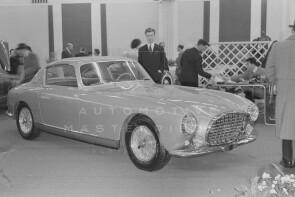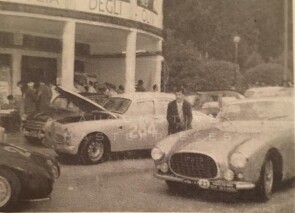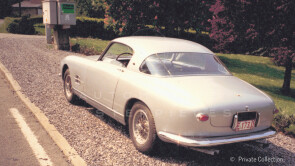
1954 Ferrari 250 Europa
ON/OFF
Why am I an Automotive Masterpiece?
L. Limited edition cars
no. 17 manufactured, 3rd built
The Ferrari 250 is a series of sports cars and “granturismo” built by Ferrari from 1952 to 1964. The company's most successful early line, the 250 series includes many variants designed for road use or sports car racing. 250 series cars are characterized by their use of an engine designed by Gioacchino Colombo, with the exception of the 250 Europa. This engine was the “Tipo 125” with a displacement of “just” 2953 cc, but it was light and powerful. The 250 series was replaced by the 275 and 330 series cars.
The Ferrari 250 Europa is a car produced between 1953 and 1954 by the Italian car manufacturer Ferrari. The 250 Europa was born from the need to replace the 212 Inter. As in any Ferrari, the heart is its engine. On this occasion we are not faced with yet another evolution of the engine designed by Colombo, but with a downsizing of Lampredi's V12 up to the three-liter threshold, the first perfectly “square” Ferrari engine. This choice ends up influencing the setting of the car because, due to its size, the engine is installed on the chassis derived from the same age 375 America. It is a solution devoted to practicality and dictated by the need to standardize production. The similarities with the bigger sister continue in the bodywork details. Before the debut of the car, in the spring of 1953, the engine of Europa offered the opportunity to consider a possible participation in the Indianapolis 500. A supercharged prototype is set up which on the test bench delivers 505 hp at 6,300 rpm, but the program has no practical follow-up. The new Gran Turismo was presented at the Paris Motor Show in 1953; it was intended mainly for European markets, as indicated by the acronym itself. For that first realization it seemed normal to rely once again on the Vignale bodyshop, which on the 212 chassis had offered some of the best interpretations and transferred the latest trends inspired by the 340 Mexico to the 250 Europa. But, next to Pinin Farina's 375 America, also unveiled on that occasion, the lines proposed by Vignale appeared dated anyway, so much so that Pinin Farina was entrusted with the task of setting up the other cars. On the 250 Europa, Pinin Farina reintroduced the sober and elegant lines already seen on the 375, offering different models that differed from each other in some stylistic elements, such as the panoramic rear window or the profile of the grille with or without chrome frame, sometimes slightly recessed to give the car more impetus. At the next New York Motor Show in 1954, Pinin Farina also proposed the only cabriolet of the 250 Europa. The Ferrari 250 Europa was the first Ferrari gran turismo that managed to capture the attention of the wealthiest and not just the sportiest, combining an elegant style with a powerful engine. In America the model was presented at Luigi Chinetti's stand, with a two-tone paint job. The Ferrari 250 Europa shared many characteristics with the Ferrari 375 America: chassis was very similar but not the same on the 250 and on the 375. The V12 engine was derived from the 375 F1 Formula 1 unit, the first Ferrari winner in F1 Grand Prix with Froilan Gonzalez driver, only varied in size. The 250 Europa engine was the house's first square engine, with bore and stroke measurements of 68 mm x 68 mm, for a unit displacement of 246.95 cc and a total displacement of 2963.4 cc. The distribution was single overhead camshaft. It was powered by three 36 DCL Weber carburettors. The performances were remarkable, for the time: 220 CV at 7000 rpm; a peculiar feature, common to all Ferrari engines designed by Lampredi, were the cylinder liners screwed into the head, so as not to have the head gaskets, a sign of great design refinement. The top speed was 180-220 km/h depending on the type of final-drive ratio chosen. 22 chassis were produced; of these, 3 coupé and a cabriolet were those with body by Vignale, the others, a cabriolet and 17 coupés, by Pinin Farina. Pinin Farina's Ferrari 250 Europa features a very prominent front and a closed round tail with rounded headlights. The sinuosity of the line is appreciable, which well masks the "extra-long" wheelbase. Unique in this sense is the continuous line of the side, perhaps the best example of a linear line without a fender line, which was the strong point of the Italian designers, first of all Pinin Farina. The cockpit is typical Ferrari, with the large wooden and metal spokes steering wheel, leather seats and instrumentation gathered behind the steering wheel. The instrumentation is Veglia Borletti and includes a very special mediometer. The spoked rims, by the Milanese Borrani, are 15", painted, with steel hub and aluminum rim; they are fitted with 7.10-15 tires, Pirelli for Italy and Firestone for the US market. The car has no rear windows while the quarter windows, on the equipped specimens, have a compass opening.
The car with chassis no. 0303 is the 3rd produced of the 17 Ferrari 250 Europa built with Pinin Farina Coupé body; this is the car of the January 16, 1954, Brussels Motor Show cars. Born for the Brussel salon, this model was set up by Ferrari with unique body colors used only for this car in the 250 series Europa. The body is two-tone colored in Artic Green with a contrasting dark green band at the bottom along the side; the interior is in light (Arbo) green leather. This is the three-window model, more desirable than the “five glasses”, since the “three-window” has a much purer line. The chassis 0303 was set up by Ferrari with a configuration suitable for racing. In fact, chassis 0303 mounts the increased differential ISO 340 Mille Miglia necessary to manage greater torque supplied by the Lampredi engine. Initially, all 250 Europas were designed with the 3-liter version of the Lampredi V12. This engine, known for its larger size and torque-oriented characteristics, was well-suited to meet the demands of a powerful grand tourer. However, it appears that Ferrari produced a limited number of 250 Europas with the 'Lampredi' engine, and then changed direction during the production process, installing the Colombo V12 in later cars. It is possible that Ferrari tested the different power units for technical choices and production cost considerations. Therefore, the precise number of 250 Europa cars equipped with the Lampredi engine remains a subject of debate. The figure of 5 units is often cited by some experts in the field, while other sources mention 6 or more units. Sn. 0303 was among these few. After this initial phase, many 250 Europas were equipped with the smaller Colombo V12, which later became the standard for the subsequent model, the 250 Europa GT. In the first part of its life, sn. 0303, although it was not a true “sport” car, it was registered under Scuderia Ferrari, as happened with other cars belonging to the Commendatore. It was first recorded 9th March 1954, and 2nd owner was Giuseppe Bianchi, who acquired it for the price of Lit. 9,500,000 and got the Italian Plate AP 014386 on May 21, 1954. The Bianchi family was a family of artists and architects of noble extraction. Giuseppe Bianchi saw the car at the Brussels Motor Show and immediately fell in love with it. By virtue of the friendship that bound him to Enzo Ferrari he obtained the direct sale of the car through the Scuderia Ferrari in Modena. Chassis 0303 is one of the very rare 250 Europa that have a race story. We have evidence of the car in competition at the 1954 Rally di Venezia, driven by Giuseppe Bianchi with entry number 23. The car ranked 4th overall. In spring 1955, the car attended to three other racing events near Rome with Giuseppe Bianchi at the wheel: the Giornata Dei Primati, the IV Coppa Dei Laghi (3rd in class) and the Coppa d'oro del Bolide Rosso (1st in class). In 1955, June 07 it was sold by Giuseppe Bianchi to Contraves Italiana SpA, involved in the production of military technology, for the price of Lit. 5,000,000 gaining the Italian Plate ROMA 226802. In 1960, January 15 it was sold by Contraves Italiana SpA to Ugo Minighini. But it would seem that, in the years after 1958, there was only "on paper" ownership. In the meantime, the car was actually owned by two famous English racing drivers: Mike Hawthorn and David Piper. 4th owner was, hence, Mike Hawthorn, iconic F1 champion in 1958 with Ferrari. Hawthorn had been the first Englishman to receive a mandate from Enzo Ferrari for the opening of a Ferrari dealer in England that he was preparing to start with his partners. Hawthorn had purchased the car from Italy through Ugo Minighini for his personal use, subsequently providing only the registration which after his death was turned directly to David Piper's entourage. 5th owner David Piper purchased the car in 1959 from Mike Hawthorn, just before he had the tragic accident where he lost his life. David Piper, recently interviewed, has provided rare photos of the 250 Europa chassis no. 0303 in the early 60s in the iconic garage of his legendary team while he was intent on painting it with the famous green livery used by his racing team. In more recent years the car has been part of important collections, attending at important events for classics. Of the 22 Ferrari 250 Europa produced, only a few have arrived today with their original bodywork and their original mechanical parts, but none also has a unique color like the 0303. Recently the car was inspected by Ferrari Classiche who found the original markings in all its parts. Matching Numbers, it’s all original, body too. It still retains its original front bracket that holds the radiator fan, which confirms that this car has never suffered accidents. The various components such as seats, bumpers and internal components are still branded with their original numbers. The bolts have never been removed. The engine compartment retains its original colors. The wheels are original too. The car is in excellent condition, because it has only traveled 35,000 km from new. The Ferrari Classiche department considered it one of the more completely and originally 250 Europa. Since the Ferrari 250 Europa is considered the first real Ferrari GT and so the 0303 being so original, is of great historical interest, also important for Ferrari Factory. The car is, of course, eligible for the Mille Miglia. The car has been restored to its pristine colors, all its part preserved and is now in stunning conditions. All the mechanics has been restored too. Restoration was executed by specialist Quality Cars (Padova – Italy), under the supervision of Mr Emiliano Torkar of Ferrari Classiche that certified the car. Chassis no. 0303 preserve all his original books ant tools including the original brochure and the 1954 Rally of Lido di Venezia badge, the original photos and a publication of 1954 Brussels Saloon.





